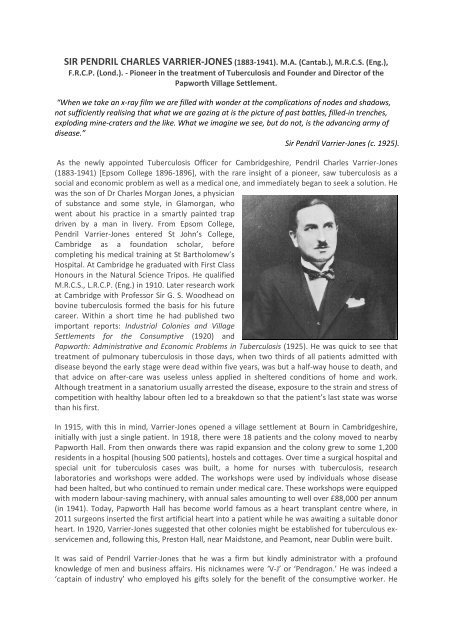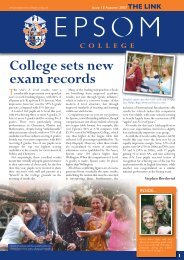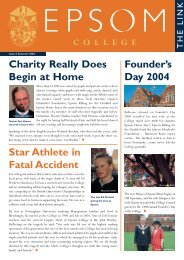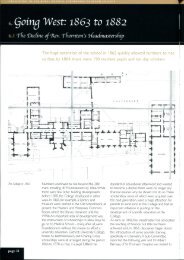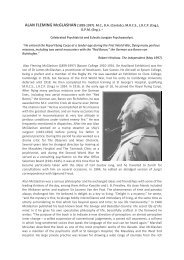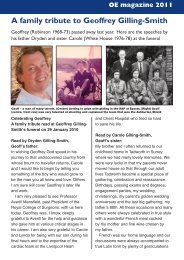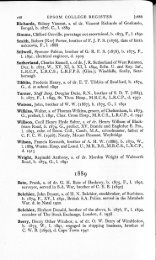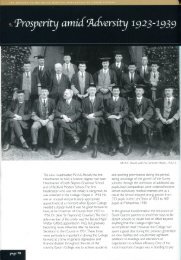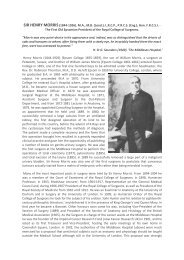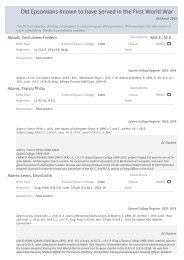Varrier-Jones, Sir Pendril Charles - Epsom College Archive Website
Varrier-Jones, Sir Pendril Charles - Epsom College Archive Website
Varrier-Jones, Sir Pendril Charles - Epsom College Archive Website
You also want an ePaper? Increase the reach of your titles
YUMPU automatically turns print PDFs into web optimized ePapers that Google loves.
SIR PENDRIL CHARLES VARRIER-JONES (1883-1941). M.A. (Cantab.), M.R.C.S. (Eng.),F.R.C.P. (Lond.). - Pioneer in the treatment of Tuberculosis and Founder and Director of thePapworth Village Settlement.“When we take an x-ray film we are filled with wonder at the complications of nodes and shadows,not sufficiently realising that what we are gazing at is the picture of past battles, filled-in trenches,exploding mine-craters and the like. What we imagine we see, but do not, is the advancing army ofdisease.”<strong>Sir</strong> <strong>Pendril</strong> <strong>Varrier</strong>-<strong>Jones</strong> (c. 1925).As the newly appointed Tuberculosis Officer for Cambridgeshire, <strong>Pendril</strong> <strong>Charles</strong> <strong>Varrier</strong>-<strong>Jones</strong>(1883-1941) [<strong>Epsom</strong> <strong>College</strong> 1896-1896], with the rare insight of a pioneer, saw tuberculosis as asocial and economic problem as well as a medical one, and immediately began to seek a solution. Hewas the son of Dr <strong>Charles</strong> Morgan <strong>Jones</strong>, a physicianof substance and some style, in Glamorgan, whowent about his practice in a smartly painted trapdriven by a man in livery. From <strong>Epsom</strong> <strong>College</strong>,<strong>Pendril</strong> <strong>Varrier</strong>-<strong>Jones</strong> entered St John’s <strong>College</strong>,Cambridge as a foundation scholar, beforecompleting his medical training at St Bartholomew’sHospital. At Cambridge he graduated with First ClassHonours in the Natural Science Tripos. He qualifiedM.R.C.S., L.R.C.P. (Eng.) in 1910. Later research workat Cambridge with Professor <strong>Sir</strong> G. S. Woodhead onbovine tuberculosis formed the basis for his futurecareer. Within a short time he had published twoimportant reports: Industrial Colonies and VillageSettlements for the Consumptive (1920) andPapworth: Administrative and Economic Problems in Tuberculosis (1925). He was quick to see thattreatment of pulmonary tuberculosis in those days, when two thirds of all patients admitted withdisease beyond the early stage were dead within five years, was but a half-way house to death, andthat advice on after-care was useless unless applied in sheltered conditions of home and work.Although treatment in a sanatorium usually arrested the disease, exposure to the strain and stress ofcompetition with healthy labour often led to a breakdown so that the patient’s last state was worsethan his first.In 1915, with this in mind, <strong>Varrier</strong>-<strong>Jones</strong> opened a village settlement at Bourn in Cambridgeshire,initially with just a single patient. In 1918, there were 18 patients and the colony moved to nearbyPapworth Hall. From then onwards there was rapid expansion and the colony grew to some 1,200residents in a hospital (housing 500 patients), hostels and cottages. Over time a surgical hospital andspecial unit for tuberculosis cases was built, a home for nurses with tuberculosis, researchlaboratories and workshops were added. The workshops were used by individuals whose diseasehad been halted, but who continued to remain under medical care. These workshops were equippedwith modern labour-saving machinery, with annual sales amounting to well over £88,000 per annum(in 1941). Today, Papworth Hall has become world famous as a heart transplant centre where, in2011 surgeons inserted the first artificial heart into a patient while he was awaiting a suitable donorheart. In 1920, <strong>Varrier</strong>-<strong>Jones</strong> suggested that other colonies might be established for tuberculous exservicemenand, following this, Preston Hall, near Maidstone, and Peamont, near Dublin were built.It was said of <strong>Pendril</strong> <strong>Varrier</strong>-<strong>Jones</strong> that he was a firm but kindly administrator with a profoundknowledge of men and business affairs. His nicknames were ‘V-J’ or ‘Pendragon.’ He was indeed a‘captain of industry’ who employed his gifts solely for the benefit of the consumptive worker. He
was forever planning new departures to meet the existing situation. Shortly before his death he wasplanning to establish a school of tuberculosis at Papworth. “If necessary,” he wrote, “I shall startwith one student.” At the time of his death he had reached the summit of his career and hadreceived the recognition that he so thoroughly deserved. He was knighted in 1931, was elected aFellow of the Royal <strong>College</strong> of Physicians in 1934, delivered the Mitchell Lecture on the subject ofvillage settlements for the tuberculous in 1927, and was awarded the Weber-Parkes Prize for hisstudies in tuberculosis in 1939. He would have been the Government’s representative at themeeting in Berlin arranged for September 1939 of the International Union against Tuberculosis, butwar intervened. In his obituary it is stated: “[His sudden death] deprives the profession of a greatauthority whose work, though now widely recognized, he did not regard as nearly complete.Endowed with great power of work, enthusiasm, and sane imagination, he had a genius fororganisation.” A distinguished colleague, <strong>Sir</strong> Arthur McNalty, wrote: “I have never known a man ofgreater single purpose. He devoted his rare holidays for the most part to visits abroad in order tostudy foreign problems of tuberculosis. He was ever planning new departures to meet the existingsituation. <strong>Varrier</strong>-<strong>Jones</strong>’s place in the history and development of anti-tuberculosis work is a veryhigh one, and mankind has lost one of its benefactors.” The village settlement at Papworth hasbecome his memorial. The Duke of Kent has been its president since 1935, and no less than sixmembers of the Royal Family have been its patrons.


